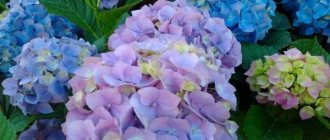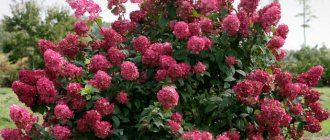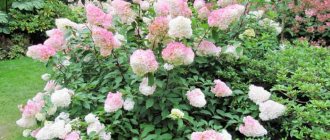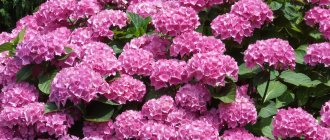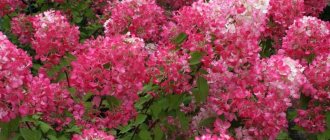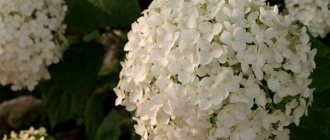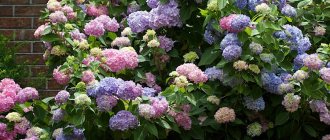Landing
The ideal time to plant a hydrangea bush is spring.
You can also carry out this procedure in the fall, but you need to leave time for the plant to adapt and take root before the arrival of winter frosts. It is better to choose a place for planting in advance, since the bush does not like transplants.
An open area under the scorching sun is not the best place for planting; delicate inflorescences can be seriously damaged. A shaded place with no sun will also have a negative impact. The most successful area will be with light shading. Gentle lighting is just what you need for lush hydrangea blooms in the garden.
Since the bush loves water, it is better to plant it away from other large plants that can take up moisture.
Landing algorithm:
- The roots should first be disinfected by soaking them for some time in a weak pink solution of potassium permanganate.
- A pit is prepared for planting measuring 40 x 40 and 50 centimeters deep.
- If the land is not fertile, then prepare a soil mixture of peat, humus and river sand in equal parts
- The roots are evenly distributed and covered with soil, leaving the root collar on the surface. After this, lightly compact the soil around the bush.
- Carry out abundant watering, and then mulch the tree trunk circle to prevent the soil from drying out.
- If it is necessary to plant several bushes, then maintain a distance of one and a half to two meters between them, taking into account the future growth of the bushes.
- Under no circumstances should you fertilize the soil for hydrangeas with ash and lime. This will lead to an alkaline reaction, which the plant cannot tolerate!
Hydrangea 'Vasterival'
In most modern varieties of hydrangeas, the vast majority of flowers in the inflorescence are sterile (sterile), they are much larger in size and look much more impressive. Today, with the growing popularity of natural gardens, there is a demand for forms of hydrangea that are close to natural, that is, with the presence of both sterile and fertile (seed-forming) flowers. Despite the fact that the caps of such hydrangeas do not look so lush, the Vasterival has an aroma lost by many sterile varieties and the ability to attract many pollinating insects. The maximum height of a bush of this variety is 1.4 meters, the width of the plant is slightly more than one meter.
I have had this hydrangea for many years now and I really like its unusual appearance. The middle of the inflorescence of the hydrangea “Vasterival” seems fluffy due to the abundance of small, unique flowers, and the sterile flowers on long stalks resemble sparks of fireworks. In general, the inflorescence looks like an enlarged viburnum, and viburnum is very attractive to me. The aroma of flowers has honey notes. And I always observe a lot of insects on the inflorescences. The foliage and habit of this hydrangea are identical to the old hydrangea variety "Annabelle".
Hydrangea 'Vasterival'. © Lyudmila Svetlitskaya
Planting and soil and site selection
Before planting the Anabelle hydrangea in open ground, it is necessary to determine the location for the future bush. This shrub is used both in single plantings and as a hedge. All this influences the choice of landing site, but in any case there are several conditions that this site must satisfy:
- No drafts or strong gusty winds;
- Sufficient soil moisture, but not stagnant moisture;
- Good diffused lighting with shading from the sun during the midday hours;
Tree hydrangea Anabel does not tolerate drafts and gusts of cold wind. Therefore, the landing site must be protected by a house wall or fence.
Hydrangea should not be planted in wetlands. It is best to keep soil moisture moderate. In dry places, Anabelle hydrangea can grow and develop well only with abundant and frequent watering.
The plant requires good lighting, but direct sun can hit its leaves only in the morning and evening hours.
The correct choice of soil also greatly influences the development of the bush and its flowering. Hydrangea tree Annabel loves slightly acidic soils, but does not tolerate alkaline ones. The presence of chalk and lime in the soil will stop the growth of the bush and then lead to its death. If unsuitable soil is found at the planting site, the planting hole should be filled with a soil mixture with peat added to it. The soil mixture should contain the following components in equal parts:
- Turf land;
- Humus;
- Peat;
- Sand and sawdust.
Anabelle hydrangea is planted in the ground in the spring in mid or late April.
Sometimes planting is carried out in the fall at least 1 month before the onset of cold weather. The best planting material is 2 or 3 year old bushes.
When planting, you need to prepare a hole about 50 cm wide and the same depth. A drainage layer of stones and broken bricks is placed at its bottom. It must be at least 5 cm thick. Sprinkle a little soil mixture on top. The roots of the plant are placed in a hole, straightened well and covered with soil.
After planting, the bush must be watered well. Typically, 1 – 1.5 buckets of water are consumed per bush. After planting, the plant is watered frequently - every other day, and with the onset of warm weather - daily.
Variety of varieties
Nature has created many types of hydrangea, and man collaborates with it, working to develop new varieties with even more beautiful and original inflorescences. Let's describe some of them.
Tree hydrangea "Incrediball" includes several types of deciduous shrubs, which can also be climbing, spreading plants. The tree hydrangea shrub is no more than 3 meters in height, with large leaves and lush inflorescences. The flowers of all types of hydrangea, for all their beauty, are sterile.
Tree hydrangea "Incrediball" grows well in moist, slightly acidified soil with a pH of no more than 5.0, although it can also grow on slightly alkaline loams.
Inflorescences appear on fresh shoots of this year, and bloom almost all summer - from June to September, some types of hydrangea delight with their flowers throughout September.
There are several varieties of tree hydrangea, which differ in flowering time, shades, shape and size of inflorescences. Some of them were given to us by nature itself, some arose thanks to the efforts of breeders.
Hydrangea "Annabelle" has white, round inflorescences, with flowers closely adjacent to each other. Breeders have developed another variety of the variety - “Pink Annabelle” with pink flowers.
Tree hydrangea “Strong Annabelle” is called “Strong” because not every shrub can support such giant inflorescences, which, moreover, bloom for a very long time. The size of the inflorescences can be increased through proper pruning, as a result of which the white inflorescences can reach a diameter of 25-30 cm. In early spring, weak and frozen branches should be removed, and strong shoots should be pruned, leaving 2-4 nodes. The strong anabel hydrangea shrub itself is not tall - only about one and a half meters in height, its leaves are large and wide.
Tree hydrangea "Strong Annabelle" is resistant to disease and severe frost, and easily recovers from frost.
Tree hydrangea "Grandiflora" has the same large inflorescences as those of the Annabelle variety, but they do not have such a regular and symmetrical shape.
Tree hydrangea "Grandiflora" is a shrub about two meters high and a crown with a diameter of 3 meters. The inflorescences are creamy-white, up to 20 cm in diameter. Blooms profusely from June to September. There are no fruits; dry inflorescences remain on the branches all winter.
The leaves are light green, up to 16 cm long, the roots do not lie deep, and they form shoots on light soils.
This variety of hydrangea does not tolerate drought, but is resistant to frost. Loves acidic or slightly alkaline soil enriched with humus. In spring, hydrangeas need to be cut to the ground, in which case they will grow larger. If you prune the branches at different levels, the shoots will bloom sequentially.
Tree hydrangea "Hayes Starburst" is distinguished by large inflorescences with double flowers. The flowers in the inflorescence are arranged randomly and do not form balls, as in the Anabel variety.
The hydrangea bush of this variety is not tall - 1-1.5 meters high, grows slowly, blooms longer than the Anabel variety, because new petals constantly appear in the center of the inflorescence.
Tree hydrangea "Hayes Starburst" prefers loose, moist, acidified soil rich in humus. Does not like calcareous soil. The plant is frost-resistant, but by the end of winter many frost-damaged branches appear on it, which need to be pruned in the spring. Pruning is done before the sap begins to flow, or before the leaves begin to dissolve.
Tree hydrangea “Sterilis”, “Sterile” (Sterilis) - the inflorescences of this variety are lush and elegant, at the beginning of flowering the flowers have a light green color, turning into snow-white balls over time. The plant of this variety blooms longer than the Anabel variety.
Tree hydrangea “Pink Percussion” differs from other varieties in its pyramid-shaped inflorescences with small pink flowers and a pleasant honey aroma.
The bush is low - from 100 to 120 cm, the width is the same, the leaves are dark green, the shoots are reddish in color. The diameter of the pyramid-shaped inflorescences is 10-15 cm. The variety blooms from June to August. The requirements for soil, lighting and care are the same as for other varieties.
Description of the plant
Tree hydrangea is a bush with spreading branches, one to three meters high. It all depends on the specific plant variety.
The entire bush is strewn with huge inflorescences. One inflorescence can reach thirty centimeters. It contains both small fertile flowers and large sterile ones. The largest flower in an inflorescence is usually no more than three centimeters.
The leaves of the bush have a round, elongated shape, which looks simply stunningly beautiful in an ensemble with inflorescences. This can be seen in the photo. Some types of hydrangea remain green all year round, while some have red foliage.
Hydrangea is often used in landscape design; it is suitable for both living fencing and flower arrangements. Clematis and roses will be a wonderful neighbor for her.
Hydrangea tree Annabelle - description
The Annabelle variety is a small bush up to 1.5 meters high. Its crown is formed by bright green leaves. Their shape is oval, length – up to 20 centimeters. They retain their color until the first frost. At the end of the first summer month the plant blooms. The bush is covered with dense inflorescences, the size of each flower is about 2 centimeters. Often the crown diameter reaches 3 meters.
The peculiarity of the Annabelle variety is that it is resistant to cold climates. This allows it to be grown in our latitudes. It is not fussy to care for; it can retain its decorative appearance for up to 50 years and does not require replanting.
Tree hydrangea "Annabelle" is capable of absorbing dyes from the soil, as a result of which the color of its flowers may change. For example, the presence of aluminum in the soil can change the white color of the inflorescences to blue.
One of the subspecies of the variety is tree hydrangea “Strong Annabelle”. It requires the same conditions of care; the bush grows no more than 1.5 meters in height. The only difference is in the inflorescences. The flowers are much larger, they are so abundant that sometimes you can’t even see the presence of foliage. Flowering begins with the arrival of summer and continues until the beginning of autumn.
Hydrangea arborescens "Pink Annabelle" gets its name from the pink hue of its inflorescences. This subspecies is frost-resistant. Inflorescences form in mid-summer, flowering continues until late autumn. The height of the bush, as a rule, does not exceed 1 meter, the stems are denser.
Use in landscape design
When using the versatile and at the same time unusually beautiful Strong Annabelle hydrangea in landscape design, it is possible to achieve amazing results. After all, the long-lasting effect of flowering and elegance in the design of any garden, park, flower bed, or personal plot will depend on it. By growing hydrangeas alongside other varieties of spring and fall flowering crops, a constant contrast can be achieved.
Strong Annabelle will look great on the shore of a small pond located on a property or in a park . It is here that the moisture-loving hydrangea can “make friends” with other equally moisture-loving crops. Hydrangea variety Strong Annabelle should be planted at a sufficient distance from other shrubs and trees, as they will take away the necessary moisture from it. Clematis, lilies, spirea and rose bushes can be excellent neighbors for this plant.
Wintering Hydrangea Anabel
Conditions of a temperate climate are well tolerated by an adult plant of this variety. Shelter is required in the following cases:
- if the hydrangea is still young, frost can destroy the shoots and root system;
- in harsh winter conditions, it is advisable to hide the adult hydrangea Anabel.
Preparation for the winter period begins with covering the soil in the root area with sawdust, leaves; the best material would be peat. To cover the bush, bend the branches to the ground so that they are not injured; you can secure them with wire staples. Place spruce branches on top of the bush, sprinkle with peat again and cover with agrofibre. The last layer will be oilcloth, which should be reinforced along the edges with bricks or other heavy objects.
Hydrangea Anabelle, older than 5 years, can withstand frosts down to -40°C, but it is still recommended to insulate the root system in case a small layer of snow falls.
Diseases and pests
Strong Annabelle is resistant to various diseases and pests, but for the purpose of prevention it is recommended to treat the bushes with Bordeaux mixture. It should also be taken into account that with a lack of iron, a disease such as chlorosis may occur.
Iron supplements can help eliminate the problem. Sometimes hydrangeas are attacked by aphids and spider mites. To control pests, you need to use the drugs “Tiofos”, “Kleschevit”, “Fufanon”, etc.
You might be interested in learning about the Baby Lace panicle hydrangea variety.
How to properly care
Annabelle is called a “forgiving” hydrangea - she will forgive many of the owner’s mistakes. But it will show its full beauty with proper care.
Watering
Annabelle arborescens Hydrangea should be watered with soft water (rain or settled tap water) so that the soil is moist but not wet. The top layer of soil should dry out 1-2 cm between waterings.
Florists at an arboretum in Illinois are adding hydrogel granules to the tree trunks of hydrangeas. They are buried to a depth of 3-10 cm around the roots - this maintains a constant level of humidity required by the plant.
There are 4 stages of water shortage:
- In summer the flowers turn green.
- The leaves wither, but do not fall.
- Leaves fall.
- Flowers fall.
If the plant is in 2 or more stages, it is “cast” gradually - shock doses of water after a long drought are most harmful to hydrangeas. In this case, flower growers recommend using drip irrigation at ambient temperature.
To keep the soil moist, mulch the tree trunk circle.
Annabelle is watered with slightly acidified water 3-4 times per season - 1 tsp. vinegar or citric acid solution per 3 liters of water to prevent chlorosis.
Feeding
Hydrangea is a profusely flowering deciduous shrub. To form green mass, it needs a large dose of nitrogen at the beginning of the growing season, a lot of phosphorus during budding and potassium in preparation for winter.
Hydrangea Anabel photo description
Based on this, the feeding scheme is as follows:
- March-April - complete complex fertilizer with a high concentration of nitrogen or a mixture of potassium sulfate and urea - 1 tbsp. spoon for 10 l;
- end of May-June - superphosphate with the addition of a small amount of urea in a 2:1 ratio, natural organic matter - nettle infusion, slurry;
- August-September - potassium magnesium or potassium sulfate, superphosphate - 1 tbsp. l per bucket of water.
If mineral fertilizers were introduced into the planting hole during planting, no fertilizing is carried out in the first 2 years.
This flower requires a sufficient amount of iron, mainly in chelated (easily digestible) form. If there is a lack of this substance in the soil, the bushes will be affected by chlorosis. Therefore, at least once a season you need to give fertilizers specially created for hydrangeas.
Trimming
Anabel forms a beautiful shape and large inflorescences only with regular trimming. Pruning is carried out both in the fall, before snowfalls, and in the spring.
Tree hydrangea can be pruned “to the stump” in winter - it will still bloom next year, because buds form on the shoots of the current year. But in order for the bushes to be of a respectable size, pruning is carried out to a height of 50-60 cm.
Cut flush with the ground:
- crooked, thin stems;
- shoots growing inside the bush;
- shoots older than 3 years.
If the branches are left to their entire length, cutting off only the inflorescences, the hydrangea will bloom, but will no longer be able to form large caps.
In the spring, before the sap begins to flow, pruning is also possible. At this time, damaged or frozen shoots are removed until the first pair of healthy buds.
If you did not have time to prune the bush in the spring months, the next suitable time for it is after the leaves bloom.
Loosening and mulching
To maintain moisture in the soil, the best operations are loosening and mulching the tree trunk circle, as well as removing weeds. It must be remembered that hydrangea's roots are located close to the surface, so loosening should be no deeper than 5-7 cm.
Loosen the soil after watering to reduce capillary evaporation and provide air permeability to the root system.
The most suitable materials for mulching are those that can increase soil acidity:
- sawdust;
- peat;
- pine litter.
Proponents of biofarming at the University Garden of Georgia call for mulching the soil around hydrangeas with fruit litter - apples, pears - this maintains the acid balance of the soil and increases the number of earthworms. At the same time, they warn against using mowed grass as mulch: when it dries, it reduces the acidity of the soil.
Preparing for winter
Tree hydrangeas are less resistant to cold than paniculate hydrangeas, but can withstand frosts down to -25C. Even if the bush freezes, but its roots are not damaged, the plant will regenerate and bloom next year, because Annabelle forms flower buds on the current year's shoots.
Anabel hydrangea photo
Therefore, when preparing for winter, the main thing is to ensure the safety of the root system. To do this, after autumn pruning, the tree trunk circle is covered with peat, humus, and compost. Cover the top with spruce branches.
Caring for hydrangea anabel
Caring for hydrangea is easy. A young, fragile bush needs more attention: it is watered abundantly, disinfecting solutions are added, and covered for the winter. For a plant that has reached three years of age, simple agricultural techniques are sufficient for normal development.
Watering
Irrigation is a necessary procedure for shrubs. Its root system grows wide without going deep. Therefore, the plant constantly lacks moisture. Watering is carried out at least 2 times a week, preventing drying out and the formation of a crust on the top layer of soil. A bucket of rain or settled water is placed under each bush. For better flow of liquid to the roots, the soil around the bush is loosened and mulched.
Mulching
The root circle of the plant is covered with sawdust, fallen pine needles, leaves, tree bark or peat. This layer of organic matter will help retain moisture and improve the quality of the soil, prevent the growth of weeds, protect against frost in winter, and from heat in summer. The mulch is made 8–10 cm thick.
Fertilizer application
For large and lush flowering, the plant requires an acidic soil environment. To maintain the pH level, the bush is watered with water with the addition of sour milk or whey. In the spring, when the shoots “come to life”, they need minerals and organic matter (compost, diluted cow or bird droppings). Fertilizers are applied once every 2 weeks before the buds begin to open. The composition of the fertilizer can affect the color of hydrangea petals. Excess chemical elements will give the inflorescences a green tint.
Reproduction
The most popular variety of tree hydrangea is the Anabel variety, which grows up to 1.5 meters and blooms with beautiful, large inflorescences. The plant is propagated by seedlings that are grown independently or purchased from flower growers.
When purchasing seedlings, you need to pay attention to the root system and the presence of shoots. The root system should have several young shoots that differ from the old ones in a light shade
And the seedling will have 2-3 large shoots with living, healthy buds.
Saplings with an open root system are planted in the spring; during the summer they have time to take root, thanks to which they tolerate the winter well.
Hydrangea sold in pots can be planted in both spring and summer; at first it needs to be slightly shaded and given plenty of water.
In any case, hydrangea can be planted in both shaded and sunny places. To do this, you need to dig a hole measuring 50x50 cm, put peat and humus in it.
If hydrangea is planted as seedlings, you can add hydrogel to the hole, a substance that helps maintain the necessary water balance in the soil even in the heat. The roots of the plant penetrate the swollen granules and take the amount of nutrients and moisture they need.
The already swollen hydrogel is placed in the hole; if you put the granules in dry form, when they absorb moisture in the ground, they will increase in volume and push out the seedling along with the ground.
The seedlings are buried in the ground so that their root collar is flush with the surface of the earth. After planting, the hydrangea is well watered, compacted, soil is added, and mulched with peat or pine needles.
In addition, hydrangea is propagated by cuttings. In cloudy weather, cuttings are cut from last year's shoots, rooted and planted in a mini-greenhouse for cuttings. Cuttings of cuttings are lubricated with a means to stimulate root growth, cutting off half of the leaves.
For rooting, cuttings are planted in a mixture of peat and sand, taken in equal quantities, at an angle of 60 degrees. The bottom node is buried 2-3 cm deep. The cuttings are well watered and covered with film. As the soil dries, they are watered and sprayed with warm water. In winter, the container with the cuttings is placed in a greenhouse, or taken to another warm room, having removed the film. In spring, rooted cuttings are planted in open ground.
All the wonderful words about the Hydrangea tree subspecies Anabel. One of the most popular tree varieties of hydrangea. Widely distributed throughout Europe. Especially loved by the Dutch and Belgians. The streets of these countries are shrouded in numerous blooming inflorescences of the Annabelle subspecies. It is better to start getting acquainted with the family with this variety; it combines so many positive qualities. The bushes are compact in size, growing neatly in all directions. Stressos are resistant to low temperatures, so they can be easily grown in almost all regions of our country.
Landing Features
Annabelle arb. Hydrangea is an unpretentious crop. It can survive in conditions in which less hardy plants weaken and die. But it is still better to follow the rules for planting and care.
Deadlines
The optimal time for planting in the ground depends on the method of growing the seedling:
- a shoot with a closed root system (CRS) takes root well at any time of the year with a positive average daily air temperature;
- a plant with an open root system (OKS) is planted in April, when the earth has warmed up but has not yet lost much moisture. And also in the fall, a month before persistent frosts, so that the roots can gain a foothold in the soil. If the seedlings are planted too late, they must be mulched with a thick layer of sawdust or peat to protect them from the cold.
When planting in summer, the main danger is the lack of water and its rapid evaporation through the wide leaves.
In hot weather, plantings must be shaded for at least 7-10 days, watered and sprayed abundantly.
Selecting a location
Hydrangeas love the sun, but do not tolerate direct midday rays. The best place for them is a draft-free space where the sun shines in the morning (before 12 o'clock) and evening hours (after 16 o'clock).
Anabelle hydrangea
Full shade, like full sun, negatively affects decorative qualities:
- in the sun its flowers and leaves become smaller;
- with a lack of light (less than 6 hours a day), the stems stretch, the color saturation of the leaves decreases, and buds may not form.
Hydrangeas cannot compete with fruit trees for moisture and nutrition, so they are planted at a great distance from each other.
The planting site is chosen:
- without close approach of soil water, but with soil capable of retaining moisture;
- with a slightly acidic reaction;
- breathable.
Loam fertilized with compost and peat is suitable. Hydrangea will tolerate even sandy loam soil, only the amount of watering in this case must be increased.
Before planting, dig up the area, remove weed roots, and apply organic fertilizer.
Then places for planting holes are marked - taking into account the rapid growth of the crop, the minimum distance to neighbors should be at least 1.5 m.
Preparation of planting material
For planting, select seedlings 2-3 years old with a developed root system and strong shoots. The health of the plant can be determined by the turgor of the leaves, the absence of cobwebs, larvae and egg laying on them.
The soil in the container should not have a salt coating or mold, and the flower itself should not have a rotten smell.
After purchasing, the hydrangea must be prepared for planting. For this seedling:
- treated with anti-stress drugs: succinic acid (2 tablets per 1 l), HB-101 (1 drop per 1 l);
- the container is soaked and kept in water until all the air is released;
- The roots of a seedling with ACS are cut by 3-4 cm, immersed in a solution with root for 2-3 hours.

